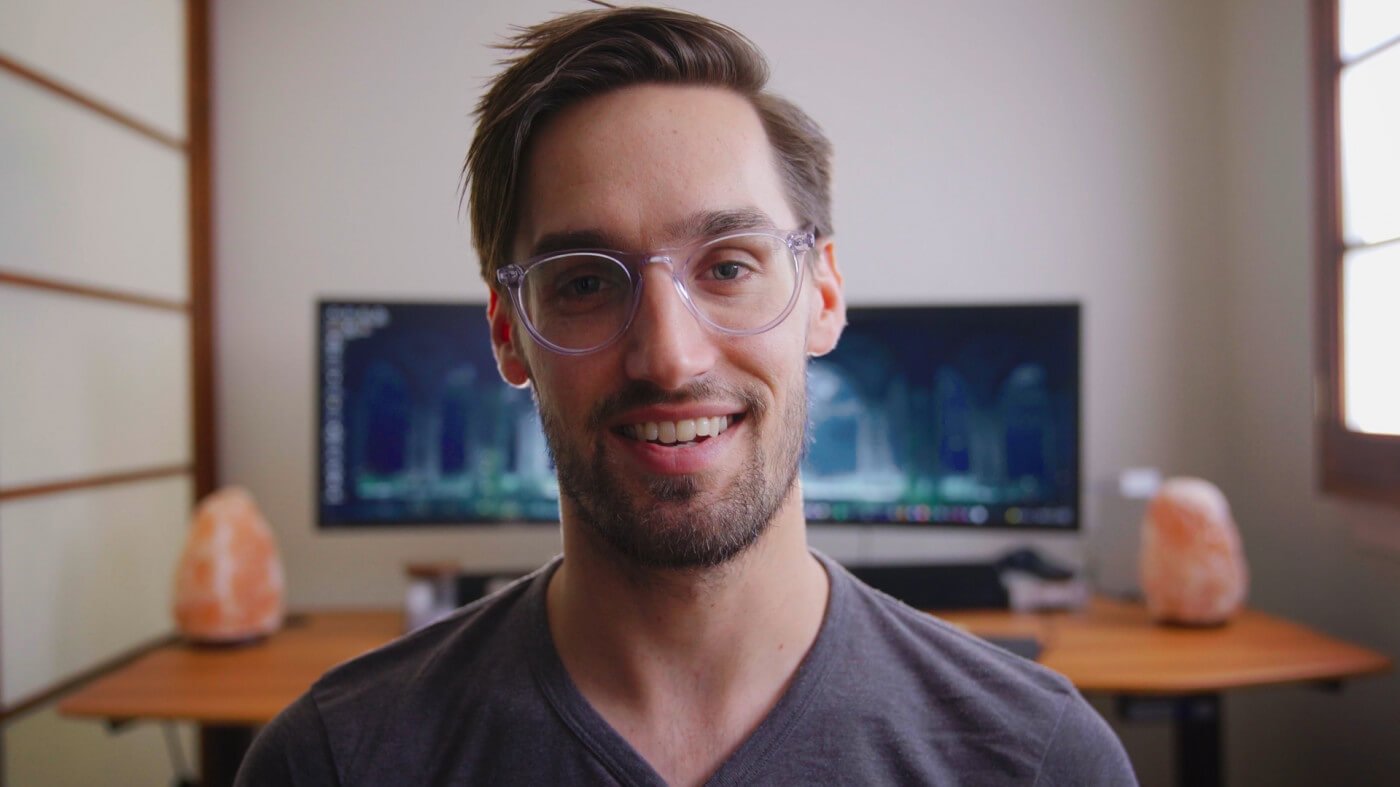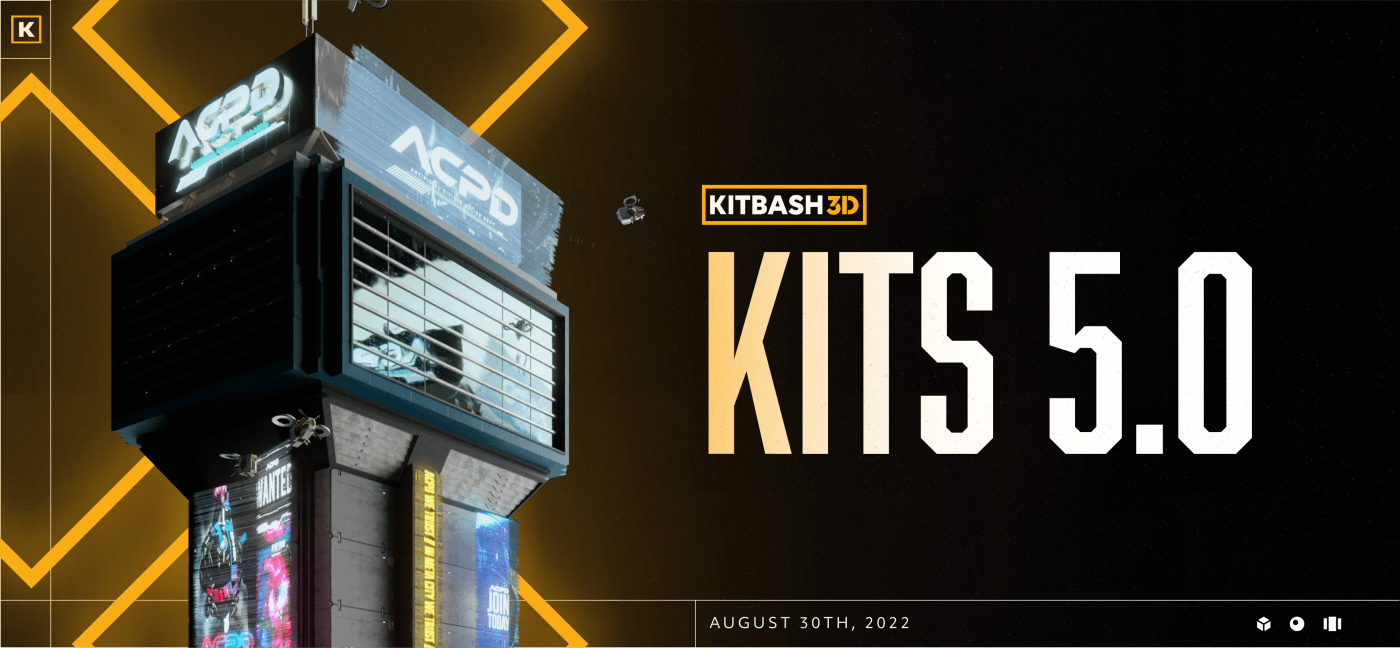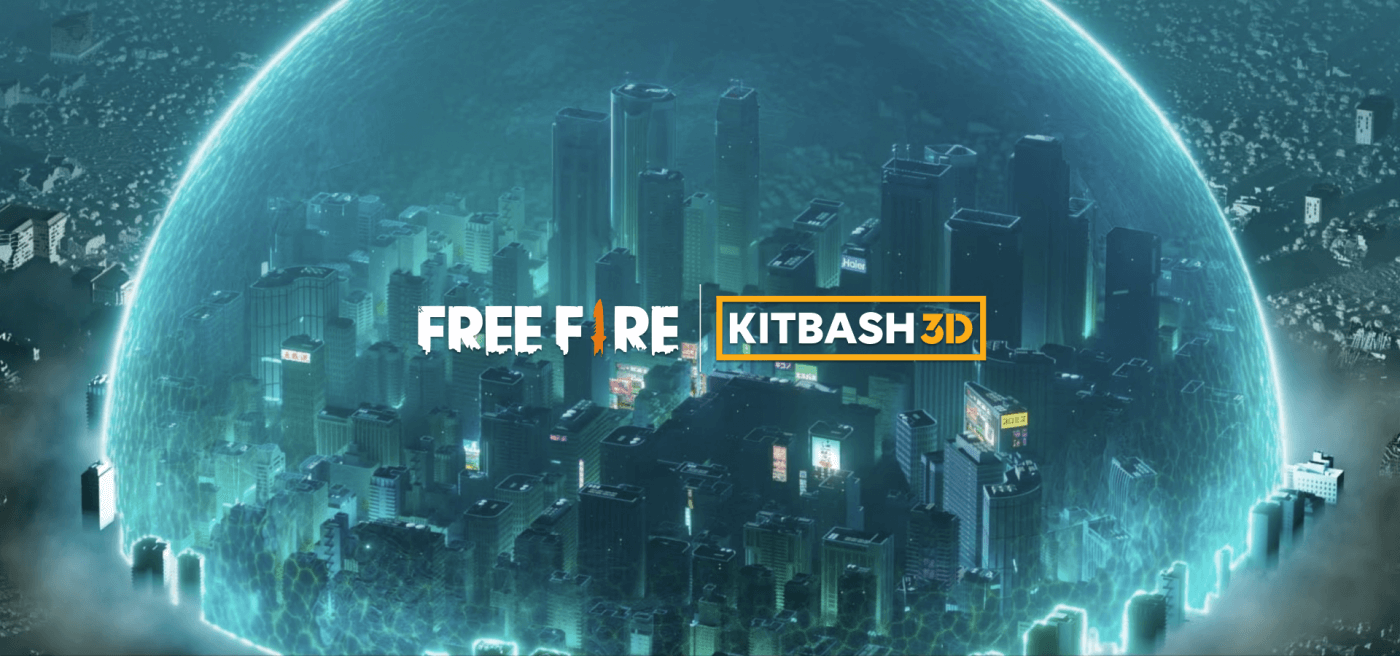Clinton Jones, or as he's known by his more than 1 million YouTube subscribers, Pwnisher, is a legend in the 3D art world. His challenges, like "Alternate Realities," are known for breaking the internet. What started out as a way to share inspiration has grown into a massive community of individuals of all ages, backgrounds, and experience levels united by an interest in 3D and VFX.
We sat down to talk with him about his latest challenge, "Moving Meditations," and his career in 3D and beyond. Read on to hear all about how these challenges were created, and a hint at what he's got planned next.
Top 100 Renders • "Moving Meditations"
KitBash3D: It’s so nice to chat with you! Many people know you from Corridor Digital, but you've since broken out on your own. Can you tell us a little in your own words about how you got started in 3D and why VFX is so important to you?
Pwnisher: Absolutely! I was introduced to the world of filmmaking back in 2006 when a friend demonstrated how his digital camcorder cut from one image to another. It was such a simple trick, but it blew me away. My buddy was also a computer whiz and told me I had free software on my PC that I could use to make little short films. No joke, he changed my life that day, and I’ve been obsessed ever since.
I fell in love with the technical side of filmmaking because I could create anything I saw in my head if I knew the right buttons to click. In theory, I was only limited by my imagination. But I realized a few years later that creating a VFX shot “just because” wasn’t a good enough reason. All the flashy effects and super cool robots meant nothing without a gripping story and fascinating characters, so my obsession for VFX and CGI became tools to tell more unique stories.
"Cardboard Warfare," an earlier short film from 2010
KB3D: Your previous CG challenges, like "Infinite Journeys" and "Alternate Realities," have highlighted talented creators and jaw-dropping work. The community response has been incredible. What led you to create these challenges, and what have been some of your favorite highlights from challenges past?
Pwnisher: A couple years ago I rebooted my YouTube channel, and the first videos I posted were simple, weekly livestreams where I’d create 3D art with my audience. Some people worked on their own art as I streamed, but a lot of people were newcomers to 3D and followed along click-by-click. At first it was pretty terrifying to show my raw, unedited process to hundreds of people, but it quickly became a fun challenge to try and create something cool by the end of the stream. Pretty quickly I realized how much fun it would be to include my audience in this “weekly challenge,” so I made a Discord server to host the challenges and started giving a prompt for each week. At the end of the week, I'd show off the best creations on-stream. I thought making these large, interactive challenges would be a great way to level up personally, create something a bit more cinematic, and bring my audience together to create something bigger than our individual selves.
These challenges take months to set up and execute, and each time we go through one, we learn a lot about what works and what doesn’t. So the most satisfying part is going through every single render with my Discord moderators, choosing the Top 100, and editing them to custom music created by my close friends. It’s where all of this collective work from the community comes together and gets compiled down to the coolest showcase possible. It’s also an absolute joy to develop meaningful relationships with these artists and to see one another grow from challenge to challenge.
Top 100 renders from a previous challenge, "Alternate Realities"
KB3D: For this challenge, you worked with a Tai chi master, Lu Junchang, to capture 27 different animations. Is there a story behind choosing Tai chi?
Pwnisher: Oh totally! I grew up practicing martial arts for the majority of my childhood. For years the only film or cinema I grew up with were Bruce Lee movies, Jackie Chan movies, and later Stephen Chow and Donnie Yen movies. These people were my heroes and are still a huge inspiration for me today. Some of the qualities that martial arts teach are discipline, persistence, and the personal reward from working hard on something. These are all things I find extremely important as we get older and as things get easier, faster, and more addicting. I believe they’re qualities we’ll all-the-sudden lose one day if we’re not actively working on them, so basing a challenge around Tai chi, or "moving meditation," felt right. But really I just thought it would look cool and be fun.
Capturing the movements for "Moving Meditations"
KB3D: You’ve made a piece for the "Moving Meditation" challenge using some of our Kits and livestreaming while you work. It's fascinating watching you build your world. Can you tell us a bit about your piece and what we can all expect to see in your upcoming breakdown video?
Pwnisher: Totally! So I wanted to create a piece of art that kicked off these montages and justified the renders that followed it. The idea was to create a virtual stage that projects VR images in a sort of lightbox volume setup, all inside a grungy warehouse. A character rigged up to some advanced VR setup would be in the middle of the stage and seamlessly cut into the montage of the community renders.
Usually I’m a Cinema4D guy, but recently I've been using Unreal Engine for its real-time capabilities, so I built my entire scene over the month of August using Unreal Engine 5. About halfway through the creation process when things were looking about 85% finished, I actually had a call with the Top 100 musician, Feverkin. He was like, “Oh I love the outdoor element to your render.” I was like, “Dude what outdoor element? It’s in a warehouse.” He was like, “Nah it’s cool how it’s under an overpass with the early morning sky in the background.” I LOVE how he was seeing something I wasn’t, and I took it as a challenge to push my render to the next level. I knocked down the 3D warehouse walls and lined them with large windows instead, setup a “dawn/dusk” kinda look, then pulled the biggest buildings from the Neo Shanghai Kit and built out a distant city. I made a custom emissive texture to fake that “night city” look and added a fake fog card to really blend them into the background. If you're interested in seeing more of the details behind that, I’ll be releasing an in-depth process for this piece on October 15th which will cover the things I’ve learned during my 3D journey and things I learned specifically on this project.
 Pwnisher's "Moving Meditations" piece, featuring our Neo Shanghai Kit. Tune in on October 15th to Pwnisher's YouTube channel to see the breakdown of how it was created.
Pwnisher's "Moving Meditations" piece, featuring our Neo Shanghai Kit. Tune in on October 15th to Pwnisher's YouTube channel to see the breakdown of how it was created.
KB3D: Unreal is a newer software for you—previously you’ve worked so much with C4D. What is it that’s drawn you to Unreal and what do you think of working with the Kits in UE5?
Pwnisher: Yeah so I started with Cinema4D R10, switched to 3DS Max for about 6 years, then came back to C4D. It’s been my go-to DCC since. But then these videos came out—ones like "Rebirth" by the Quixel team, and "Memories of Australia" by Andrew Svanberg Hamilton. I couldn’t believe they were getting such cinematic, photorealistic results with Unreal Engine! I’m such a sucker for atmospheric environments because it’s so opposite from what I see everyday in Los Angeles. I love traveling to places you might see once or twice in a lifetime. Rare spots like dark marshes, huge sewers, or fog-shrouded hilltop ruins. I wanted to visit these places again, and creating them in realtime using UE felt like the answer.
Honestly, this was my first UE project where I utilized KitBash3D assets, and I was legit blown away by how well UE handled the massive Neo Shanghai structures. I don’t know if it’s an Unreal thing, or a KitBash3D thing, but it was literally just drag, drop, and create. I can’t wait to jump back in and play with the UE and KitBash3D combo more.
KB3D: You mentioned during one of the streams struggling with character workflows. Roadblocks and learning moments are common among creators who are just jumping into 3D art for the first time. How do you approach challenges like that when you have to get out of your comfort zone?
Pwnisher: Usually I decide to learn a new thing because I'm inspired to do so. I see a cool video like that Japanese train station demo by Lorenzo Drago and I'm like, “Okay I wanna do that too.” But you can immediately feel crushed when opening DCC software because you have no idea where to start, or even what to Google. So the first thing I do is watch videos that get me hyped on the program. Then I keep that fire burning and watch tutorials on the general things I want to make, and I'll start to develop my ability to speak the language and navigate the program. Once I can maneuver around the software and understand kind of where things are, I can set out to complete one small project using the new program.
My advice is, if you're learning a new program, take on doable, bite-sized projects. That way you’re not crushing your motivation by taking on something huge and never finishing it. Work up to that stuff, keep watching tutorials, even if it’s not the thing you’re trying to do at first. Just dive in and keep following your passion. There are times where it’s not fun though, where troubleshooting has been your life for the last two weeks and you’re just ready to create some cool art. I know we can return to our familiar software to pull this off, but that’s not the point. Try to resist that urge and stick with it. You’re learning this program for a reason, and the better you can define that reason, the easier it will be to stay on track. The more we problem-solve our programs, the more proficient we'll become, and the more fun it will be. Soon we’ll only be limited by our imagination, and when it comes to expressing yourself, that’s freedom.

"Cape Spear" by Pwnisher
KB3D: You’re extremely skilled at drawing inspiration and then creating a narrative that’s totally your own. How did you develop your ability to tell a story, and how do tools like KitBash3D help you tell that story?
Pwnisher: For me, I’m guessing it came from being inspired by great stories first. Watching how Spielberg, Fincher, the Coen brothers, or Miyazaki tell stories have all been a huge inspiration for me. But it’s not just movies. Two of my favorite authors, Haruki Murakami and Neal Stephenson, couldn’t be more opposite in style and tone. However, they give you different options for how great stories can be told. We all have our favorite movies, shows, games or books, and they all add to our overall taste of what we enjoy vs. don’t enjoy. The more good stuff we actively consume, the more that can influence what we create. I mean other than that, there’s an incredible book called "Story" by Robert McKee that dives into the craft of storytelling. It’s probably one I should be reading every year.
I used to feel like I had to do everything myself. Maybe it was a way for me to feel like what I created was truly mine or something, but it made no sense to do it the hard way when the tools around me made creating art so much easier, and the KitBash3D Kits are crucial for getting the images out of my head and onto the screen as fast as possible.

"Forest Door" by Pwnisher
KB3D: What has working with some of the Kits been like for you? How do you integrate them into your workflow, and what does that mean for your work?
Pwnisher: Usually I block things out in 3D to shape my composition and lighting before diving into the details, but the KitBash3D assets let me skip this step and dive into building my scene with incredible detail from the very beginning. It’s a huge leap toward only being limited by my imagination, which is what I'm always aiming for.
An example livestream from "Moving Meditations" by Pwnisher
KB3D: How has the community you’ve created changed the way you think about and approach your own work?
Pwnisher: At first, I made tutorials and breakdowns specifically for the audience. It’s no easy task putting together a streamlined, helpful tutorial because it’s so easy to ramble on about this or that (especially for me). So what I started doing was actually writing my tutorials and breakdowns word-for-word and reciting off a teleprompter. It helped me dish out the info as efficiently as possible and also acted as a personal huge review of what I learned along the way.
Also, because of the community, I’ve found new ways to learn and grow and, in turn, give back. It’s such a satisfying loop! On top of that, people help me with my technical roadblocks on-stream via the chat. I run into them often and it seems somebody has an answer for me. We’re truly learning and growing together and it’s the absolute best!

Parallel Dimensions by Pwnisher
KB3D: You do so much for the 3D community as a whole, thank you for your contributions in making this so awesome for everyone! But we also know that, not only do you inspire others to create, you are also an accomplished filmmaker in your own right—can you give us any spoilers about your next personal piece to come?
Pwnisher: Currently I'm working on the most difficult project of my life. It’s like pulling teeth one week, and a whirlwind of creative excitement the next. I’ve written a lot of short films in the past, but every time I've tried to write a movie, I’ve failed. This time is different though. I’m going to finish this one.
Thank you so much for having me and allowing me a chance to connect with you and your audience. Rock on KitBash3D!

"Newfoundland Sewer" by Pwnisher
Pwnisher truly embodies what it means to enable and inspire a creative community, and we're so honored that he took the time to share some of his own experiences and insight with us. If you want to join in on the fun, you can subscribe to Pwnisher's YouTube channel or join his Discord.





